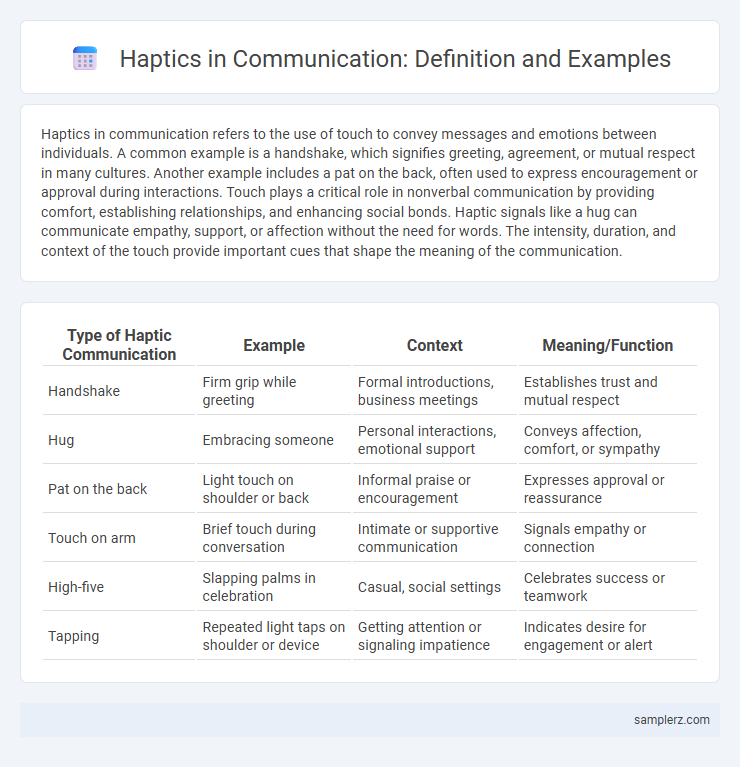Haptics in communication refers to the use of touch to convey messages and emotions between individuals. A common example is a handshake, which signifies greeting, agreement, or mutual respect in many cultures. Another example includes a pat on the back, often used to express encouragement or approval during interactions. Touch plays a critical role in nonverbal communication by providing comfort, establishing relationships, and enhancing social bonds. Haptic signals like a hug can communicate empathy, support, or affection without the need for words. The intensity, duration, and context of the touch provide important cues that shape the meaning of the communication.
Table of Comparison
| Type of Haptic Communication | Example | Context | Meaning/Function |
|---|---|---|---|
| Handshake | Firm grip while greeting | Formal introductions, business meetings | Establishes trust and mutual respect |
| Hug | Embracing someone | Personal interactions, emotional support | Conveys affection, comfort, or sympathy |
| Pat on the back | Light touch on shoulder or back | Informal praise or encouragement | Expresses approval or reassurance |
| Touch on arm | Brief touch during conversation | Intimate or supportive communication | Signals empathy or connection |
| High-five | Slapping palms in celebration | Casual, social settings | Celebrates success or teamwork |
| Tapping | Repeated light taps on shoulder or device | Getting attention or signaling impatience | Indicates desire for engagement or alert |
Understanding Haptics: The Language of Touch
Haptics, the study of touch as a form of communication, plays a crucial role in conveying emotions and intentions without words. Through gestures like handshakes, hugs, and pats on the back, individuals can express trust, affection, or reassurance effectively. Understanding haptics enhances interpersonal communication by interpreting these tactile signals to build stronger connections.
Haptics in Everyday Interactions
Haptics in everyday interactions includes handshakes, hugs, and pats on the back, serving as powerful nonverbal communication tools that convey trust, comfort, and social bonding. Physical touch such as a gentle touch on the arm or a firm handshake can instantly establish rapport and express empathy or agreement without words. These tactile signals play a crucial role in reinforcing messages and emotions during face-to-face communication.
Cultural Variations in Haptic Communication
Haptic communication varies significantly across cultures, influencing social interactions and meaning. For example, in Mediterranean and Latin American cultures, frequent and expressive touch such as hugs and cheek kisses convey warmth and familiarity, while in East Asian cultures, limited touch is preferred to maintain formality and respect. Understanding these cultural variations in haptic communication improves cross-cultural relationships and reduces misunderstandings.
Haptic Signals in Professional Environments
Haptic signals in professional environments play a crucial role in non-verbal communication, often conveying confirmation, support, or urgency through touch. Examples include a firm handshake to establish trust, a pat on the back to motivate colleagues, or a gentle tap on the shoulder to gain attention without interrupting. These tactile interactions enhance collaboration and reinforce social bonding in the workplace.
The Role of Haptics in Family and Romantic Relationships
Haptics, the study of touch in communication, plays a crucial role in family and romantic relationships by fostering emotional bonds and conveying affection, comfort, and reassurance. Physical touch such as hugs, hand-holding, and gentle caresses can reduce stress and enhance feelings of security and trust between partners and family members. Research shows that regular positive touch promotes oxytocin release, strengthening attachment and improving overall relational satisfaction.
Haptics in Healthcare Communication
Haptics in healthcare communication includes physical touch such as handshakes, comforting pats, and gentle touches that convey empathy and reassurance between medical professionals and patients. These tactile interactions enhance trust, reduce patient anxiety, and improve the overall quality of care. Research shows that positive haptic communication in healthcare settings can lead to better patient satisfaction and adherence to treatment plans.
Educational Applications of Haptic Communication
Haptic communication enhances learning experiences through tactile feedback devices that simulate touch and texture, enabling students to engage with virtual objects more interactively. In medical training, haptic technology allows learners to practice surgical procedures with realistic force feedback, improving skill acquisition without risk. Educational applications also include language learning tools that use vibration patterns to teach phonetics and pronunciation through touch.
Technology and the Evolution of Haptic Feedback
Haptic feedback technology has evolved significantly, enhancing communication by providing tactile sensations through devices like smartphones, wearables, and virtual reality controllers. Advanced haptic systems simulate textures, vibrations, and pressure, creating more immersive and intuitive digital interactions. This evolution facilitates non-verbal communication in virtual environments, improving user engagement and emotional connection.
Misinterpretations and Boundaries in Haptic Communication
Haptic communication, such as handshakes or hugs, often leads to misinterpretations due to cultural differences and personal boundaries. For example, a firm handshake may be perceived as confidence in one culture but as aggression in another, while an intimate hug might invade personal space and cause discomfort. Understanding and respecting these boundaries is crucial to avoid misunderstandings and maintain effective interpersonal communication.
Enhancing Communication Skills with Haptic Awareness
Haptic communication, such as handshakes, hugs, and gentle touches, plays a crucial role in conveying emotions and reinforcing verbal messages. Developing haptic awareness enhances interpersonal skills by improving empathy, trust, and clarity in social interactions. Mastery of touch cues leads to more effective and nuanced communication across diverse cultural and professional settings.

example of haptics in communication Infographic
 samplerz.com
samplerz.com